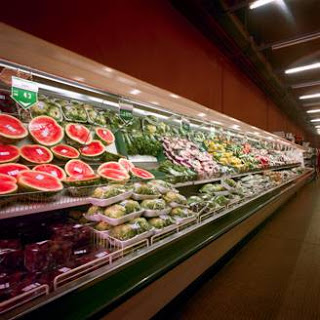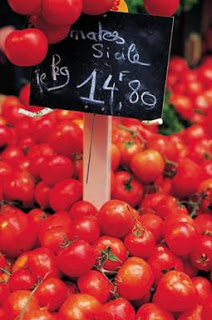Lowering the Price of Healthy Eating

Is a truckload of veggies as desirable as a truckload of flat screen TVs?
Skyrocketing food prices, a difficult economy, and lifestyles that depends on good nutrition may have created a perfect atmosphere for these produce thieves who stole a truckload of tomatoes and cucumbers valued at $42,000. The veggie heist comes on the heels of a similar incident in Florida last month in which a $300,000 worth of vegetable and frozen meat was stolen.
Such high-nutrition hi jinx may be the result of yet another mixed societal message. As a country, we get the blame for eating poorly while at the same time we are virtually enclosed by a ring of processed food; we are urged to buy fresh, whole, organic food while living in a dire economic downturn where household budgets are continually squeezed. It’s no wonder a truckload of fresh food is a precious commodity.
The Costs of Poor Nutrition
If your slip at the supermarket register is telling you food prices are rising, you’re right. According to the U.S. government’s Consumer Price Index, food prices in January rose 1.8% from the prior year, which is the fastest pace since 2009. Basic commodities have risen in price, and average nationwide vegetable prices rose 9.8% in March compared to the same month in 2010, according to the Bureau of Labor Statistics’ monthly Consumer Price Index reported this month.

At the same time, according to the USDA., the cost of food for the average U.S. household makes up a lower percentage of income than almost any other nation – just 6.9% of the average American household’s expenses. Generally speaking, even while food prices inch up, food is available to the majority of middle class Americans at low costs. But is it the right food? Why does food availability seem to parallel our poor eating habits?
Despite the ubiquity of low-priced drive-thrus and cheap bulk snack food, we can eat well for less money—we must. And in the long run, we can’t afford to do otherwise. The treatment of diseases preventable with good nutrition is raising health care costs and sabotaging our health and longevity. As American consumers, we must find a way to eat good food affordably.
Cut the Waste
The U.S. Department of Agriculture estimates that Americans waste about 20% of their food. It’s a statistic that speaks to our world of food plenty. Wasted food means we expend enormous amounts of manufacturing energy unnecessarily and watch nutrients and dollars go down the drain. A University of Arizona study estimates that the amount of waste from a typical household that shops for four adds up to $40 each week.
While bulk purchases can make budgetary sense, stocking up on perishables like fruit and vegetables is a recipe for filling the trash. How do we start cutting our waste? One European government has considering ridding labels of “best before” dates in order to curb our tossing habit. Websites like Allrecipes.com and the FoodNetwork.com can help us search out dishes based on the ingredients hanging around the house. We can shop with lists; we can organize our kitchens so we know what we have and use it. And, when we must throw out food, we can compost to give food trash a new use.
We can also loosen our standards of perfection when it comes to food. According to New York Times contributor Tara Parker Pope, the trouble with having plenty of food means we can often confuse spoilage for mere less-than-perfect. Brown spots on the lettuce? Cut it off. Not sure about that ice cream? It’s probably fine. Down to the end of that ketchup? Use it up before popping open a new bottle.
Stretch Your Food
As any good restaurant chef knows, the most efficient way to run a kitchen is to use up the food you have: yesterday’s entrée becomes tomorrow’s Soup of the Day. Start thinking like a restaurant chef and you’ll see food costs plummet. Using your ingredients takes a little creativity and a pinch of culinary acumen, but it’s a habit that will stick.
Use leftovers to make delicious soups or to fill a healthy burrito, and embrace foods like chili, shepherd’s pie and quiche to revisit ingredients and take a “stone soup” approach to make ingredients go further. This simplebites.com article called Eat Well, Spend Less offers up five frugal meals to stretch your dollar, including black bean burgers and crustless quiche that uses that scrap of ham and random cup of mushrooms and turns it into something to rave about.
Supermarkets may have some price points licked, but local markets can come out on top for some important budget-busting items. Check out local Asian markets for good prices on produce and rice, and you’ll likely find budget-friendly spices, meats, cheeses and items like olive oil at your local Italian grocer. As Livestrong.com points out in Cheap Ways to Eat Healthy, shopping at the local farmer’s markets is no luxury—they provide cheap, fresh goods that cut out middleman costs, and allow you to choose amounts based on your needs, whether that’s 1 or 8.
Make Convenience the Enemy
The myth that fast food is easy on the wallet is just that – a myth. According to Michele Hiatt, a registered dietitian at St. John Medical Center, the least-processed foods are the least expensive as well as the healthiest. Yes, you can supersize your meal for a mere dollar, but convenience food is, in general, not good economics. Making food from real ingredients is better on the wallet and the calories, and eliminates unhealthy ingredients that go into processing like those unusually high sugars, salts, and fats.
It’s just that…convenience is so convenient. But a recently article in the Atlantic Monthly called the Joy of Not Cooking points out the irony that surrounds the age of food preoccupation. We obsess over the newest ceramic kitchen knife and spend big for a tricked-out high end stove, but for all its equipment, we actually spend less time in the kitchen than ever before. For example, women who work outside the home log an average of 5.5 hours per week in the kitchen—that’s food preparation and cleanup included. Compare that to our grandmothers, who either ran or grew up in households with women who spent 30 hours a week on food preparation. If it doesn’t motivate us to add a little more preparation time, it at least puts convenience into perspective.
Hiatt discusses her “Top 5 Food Savers” in a recent article and recommends a shopping list which targets fruits and veggies in season, dried beans/legumes, frozen produce on sale, potatoes, lean protein on sale, skim milk and yogurt, and store brand rice, pasta, oatmeal, barley and grits for budget stretching.
Tap into the Season
You can keep good food on your plate and pennies in your pocket by taking local to the next level. Growing your own vegetables at home is a budget-conscious strategy, not just a hobby. According to the National Gardening Association home gardens are up from 27 million households in 2005 to about 31 million households last year. The main reasons? Better tasting food, higher quality food and saving on the grocery bill. According to Michael Pollan, any amount of land will do to start a home garden. Even his own self-described postage-stamp-sized yard with three raised beds provides him with enough to add to dinner most nights, and the price is right.
If you are looking for home farming resources, start with Brett L. Markham’s Mini Farming: Self-Sufficiency on Acre, or reveal your green thumb by using it to thumb through Lisa Taylor’s Your Farm in the City, which provides a complete look at the trend of urban farming.
Other ways to take advantage of the season include picking your own fruits and veggies. Farms that offer this labor-intensive shopping experience can give you bulk produce for a low price: find farms at pickyourown.com. Find other ways to buy fresh on a budget on eHow.com.
Finally, Make Use of Frozen
Frozen is part of any discussion devoted to nutrition and stretching dollars. It can be your secret weapon when it comes to budget cutting. Frozen fruits and veggies offer economy because of their bulk sizes and because they eliminate costly waste that gnaws at the household food budget. There’s also no competing with frozen when it comes to off-season prices and availability. Besides, having at-the-ready daily servings is incentive enough to use frozen – accessible nutrition that is just a good as fresh is worth a truckload of flat screens to any family.
Go forth and eat healthy! You can’t put a price on good health, disease prevention and longevity, so don’t let a tightening budget squeeze the nutrition off your plate. You know fruits and vegetables are the best way to get the most from your dollar when it comes to nutrition – armed with a few dollar-stretching strategies you won’t have to sacrifice good health for their powerful nutritional value.
Not sure what’s in season? Coupons are fine for boxes and cans, but for produce, taking advantage of low prices means homing in on what’s inexpensive in any given time of year. About.com’s Frugal Living
section provides an easy month-to-month reference perfect for posting on the fridge. This month, go for pineapples and artichokes; in May head toward asparagus and okra.
Go Frugal! Forward this post to start a trend in saving money and preserving health!


